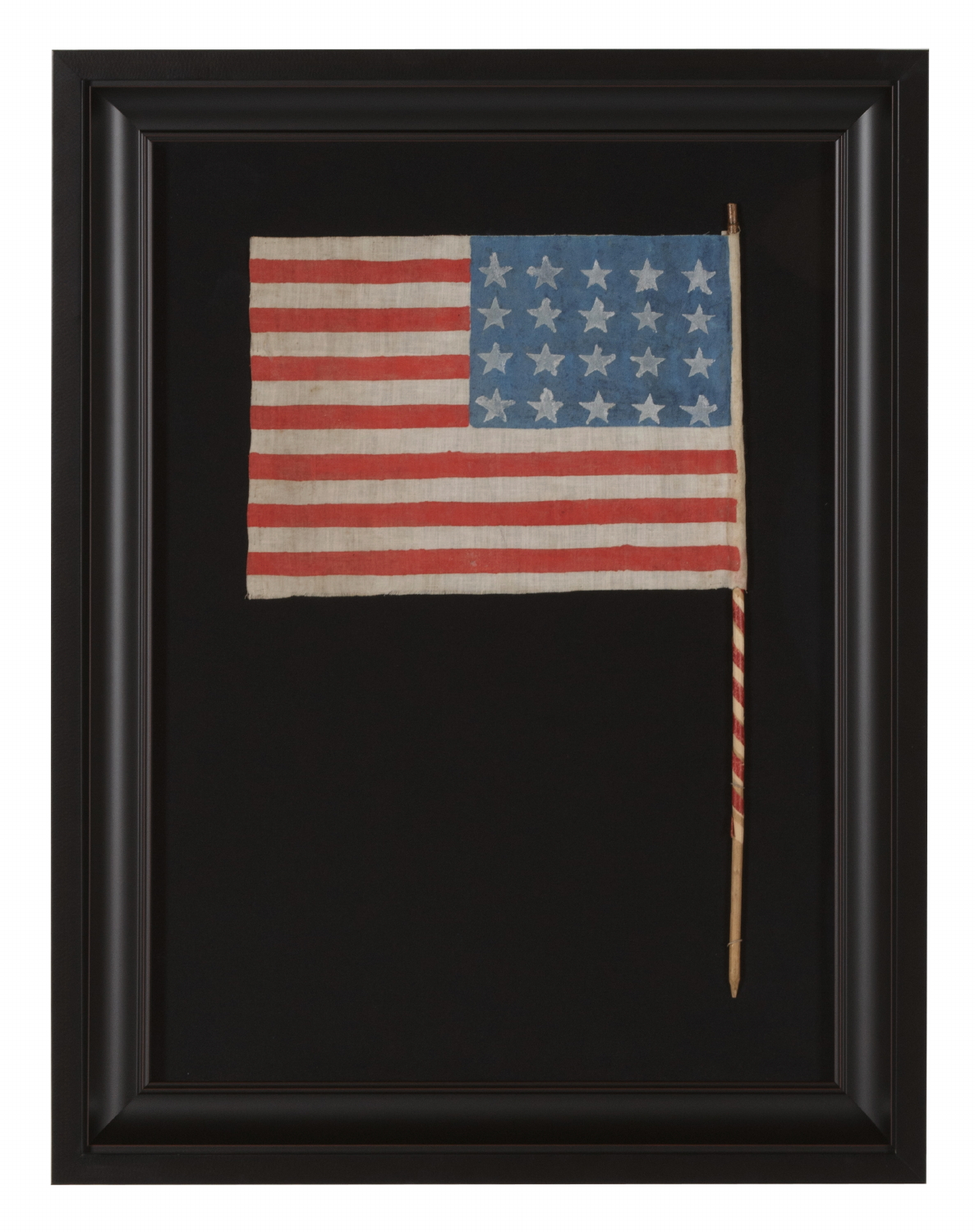
| |
WWII PERIOD HOMEMADE PARADE FLAG WITH 20 STARS, 15 STRIPES THAT START AND END ON WHITE, AND A CANDY CANE STRIPED STAFF, MADE TO WELCOME U.S. SOLDIERS AFTER LIBERATION FROM GERMAN OCCUPATION, FOUND IN CHARTRES, FRANCE, ca 1944 |
|
| Available: |
Sold |
| Frame Size (H x L): |
27.75" x 21" |
| Flag Size (H x L): |
9" x 12" on a 19.5"staff |
|
| Description....: |
|
WWII PERIOD HOMEMADE PARADE FLAG WITH 20 STARS, 15 STRIPES THAT START AND END ON WHITE, AND A CANDY CANE STRIPED STAFF, MADE TO WELCOME U.S. SOLDIERS AFTER LIBERATION FROM GERMAN OCCUPATION, FOUND IN CHARTRES, FRANCE, ca 1944:
20 star American national flag with unusual attributes and wonderful folk qualities, found in Chartres, France. The make-do construction is indicative of American flags made in Europe during both WWI and WWII to welcome U.S. troops following liberation from the Germans. The staff is wrapped in candy cane style with red painted paper ribbon and the presentation is both colorful and dynamic.
Liberation flags were often made out of recycled materials, since shortages were a byproduct of war. The makers of such flags seldom employed the correct number of stars and sometimes made error in the stripe count as well. Both are true in this case. It may be presumed that the maker seldom knew the correct total, or though it impractical to include so many stars on such a small flag, especially given the available time and materials.
The fact that the stripes begin and end on white is a rare and desirable trait. In America this circumstance primarily exists in 18th century illustrations as opposed to surviving examples. It may actually have been relatively common in the 18th century, but certainly was not any point afterwards and so is admired by collectors in flags of any period.
Chartres is a town in central France, 60 miles southwest of Paris, which during WWII, had a population of approximately 30,000. It's most noted historic site is a Christian cathedral that had, since the middle ages, served as a point of pilgrimage. The city suffered heavy damage from bombing over the course of the war, but the cathedral was spared by the valiant efforts of an American officer, Colonel Welborn Barton Griffith, Jr., who challenged an order to destroy it. It was suspected that the Nazi's were occupying the structure and utilizing it as an observation post. Griffith questioned the validity of the theory and the logic of bringing it to the ground without proper intelligence. Volunteering to go behind enemy lines, he took a single enlisted man with him and successfully confirmed the Germans had not commandeered the cathedral. The order to destroy it was withdrawn. Following deep reconnaissance missions of the 3rd Cavalry Group and units of the 1139 Engineer Combat Group, and after heavy fighting in and around the city, Chartres was liberated on the 18th of August, 1944 by the U.S. 5th Infantry and the 7th Armored Divisions belonging to the XX Corps of the 3rd US Army, under the command of General George S. Patton. sadly, Colonel Griffith was killed in action two days prior in the nearby town of Leves.
The flag was found with a small British Union Jack of homemade manufacture [not included, but available separately]. It's not especially unusual to find Stars & Stripes and British format liberation flags together.
Construction: Like many homemade flags made in haste, this one is one-sided; most known examples share this trait. The flag was made by painting red stripes and a blue canton onto a ground of plain white cotton. The stars were painted, probably with a stamp made from a potato or some other easily carved medium. The flag was glued to a wooden staff, which is partially wound with red-painted paper ribbon.
Mounting: The flag has been hand-sewn to a background of 100% cotton twill, black in color, which was washed to reduce excess dye. An acid-free agent was added to the wash to further set the dye, which was heat-treated for the same purpose. The mount was then placed in a cove-shaped molding that is so dark brown in color that it is nearly black, with overtones and highlights, to which a similar colored rectangular molding with a textured surface was added around the outer edge. Spacers keep the textile away from the glazing, which is U.V. protective glass
Condition: There is very minor foxing, but there are no serious condition issues. The staff was badly warped, but this was forced back into position and wired into place during the mounting process. |
|
|
|
| Collector Level: |
Advanced Collectors and the Person with Everything |
|
| Flag Type: |
Parade flag |
|
| Star Count: |
20 |
|
| Earliest Date of Origin: |
1944 |
|
| Latest Date of Origin: |
1944 |
|
| State/Affiliation: |
|
|
| War Association: |
WW 2 |
|
| Price: |
SOLD |
|
| |
Views: 3074 |
|
|
|

